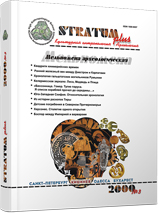Николаевский могильник – траектория во времени и пространстве
Nikolaevka Cemetery — the Trajectory in Time and Space
Author(s): Denis A. TopalSubject(s): History, Archaeology, Military history, Ancient World
Published by: Издательский дом Stratum, Университет «Высшая антропологическая школа»
Keywords: archaeological methods; Nikolaevka cemetery; Odessa region;
Summary/Abstract: This article is an attempt to transfer some archaeological methods, which make up the complex procedure preliminarily called «situative reconstruction», on materials of Nikolaevka cemetery (Odessa region, Ukraine). Correlation method or seriation was selected as basic tool for solution of the problem of internal chronology of the Nikolaevka cemetery. Correlation method and horizontal stratigraphy are fundamental for revealing internal dynamics of various types of artifacts and their regular combinations. Besides, a comparative anthropological analysis of graves can serve as a procedure of calibration of the obtained results. All this complex of the used methods is an integral procedure of situative reconstruction of the site, its chronology and interpretation. As a result of seriation of the cemetery some laws in development of grave goods have come to light and the groups of graves were distinguished. The absolute dates are too wide for strict distinction of phases, therefore the method of «narrow datings» was used as suggested by M. Shchukin. The first phase of male and female graves can be dated by the second — third quarter of IV c. BC, the second phase — second half of IV c. BC, and the third – by the late IV — first half of III c. BC. The horisontal stratigraphy helped to make clear the line of development of the cemetery. It was clarified that the cemetery developed on the line north-south. The types of offensive arms concentrate in northern, the earliest part of the cemetery. It can be quite interpreted as a sharp emission of male military graves at the early stages of existence of the cemetery connected with a growth of Scythian military activity in the region. To check this hypothesis, and also to explain the distinctions in rates of development of male and female material culture, the analysis of anthropological material was pursued. Having checked up this hypothesis, also supported by concentration of complete sets of offensive arms at early phases of existence of the cemetery, it was found out that the similar peak of quantity of the dead 25-year men is characteristic only for the first group of graves which is situated in the northern part of the cemetery. For other territorial groups such phenomenon was not observed. It is possible to conclude that at the early phases of existence of the cemetery (mainly the second phase of male graves), the population which left Nikolaevka cemetery, took part in military activities roughly dated by the third quarter of IV c. BC. The obtained result is an additional evidence in favour of written sources telling about participation of Scythians of our region in military activities in North Pontic region. The activity of Scythians of Nikolaevka site seems to be connected with wars of Ateas.
Journal: Stratum plus. Археология и культурная антропология
- Issue Year: 2000
- Issue No: 3
- Page Range: 205-228
- Page Count: 24
- Language: Russian
- Content File-PDF

